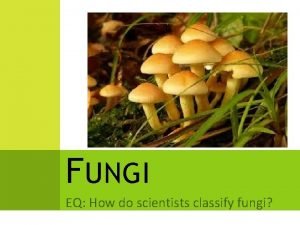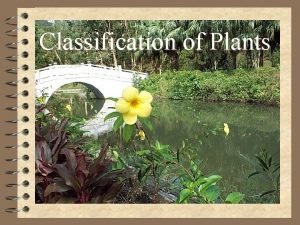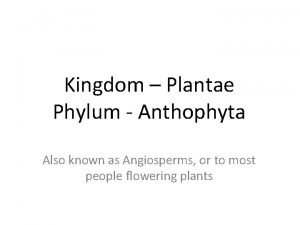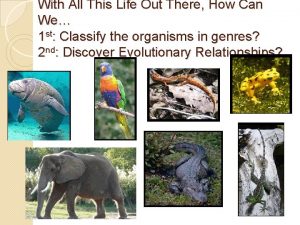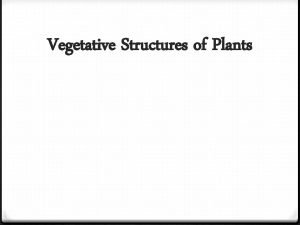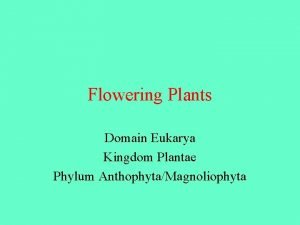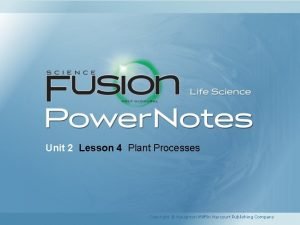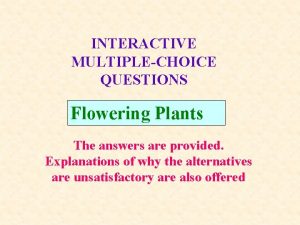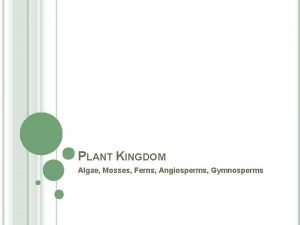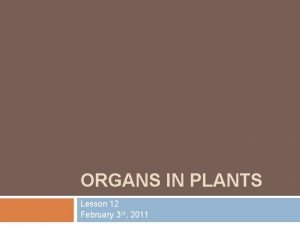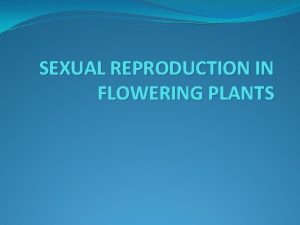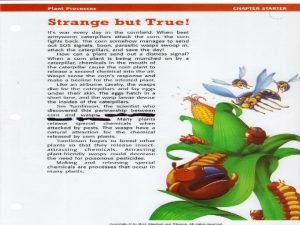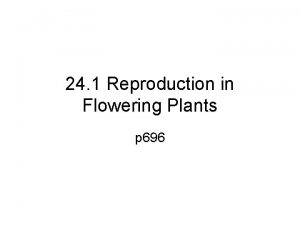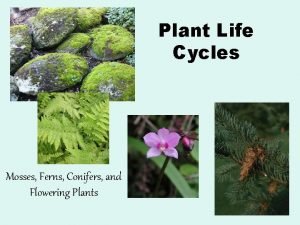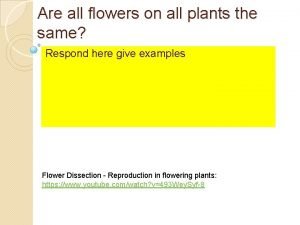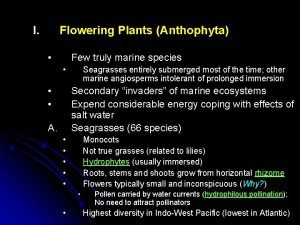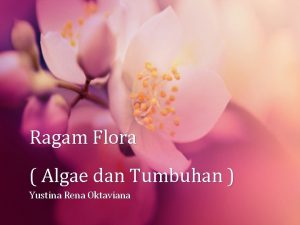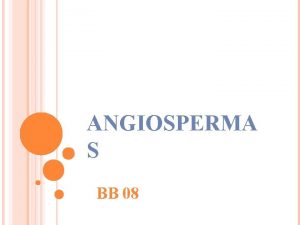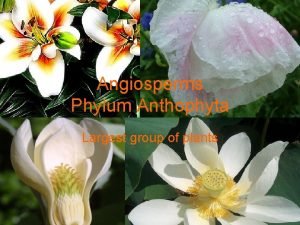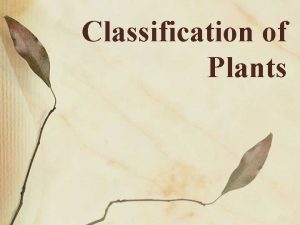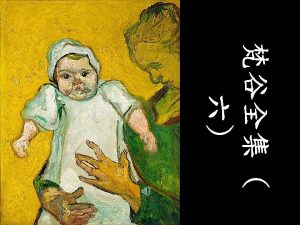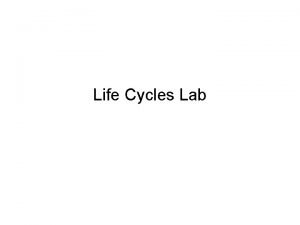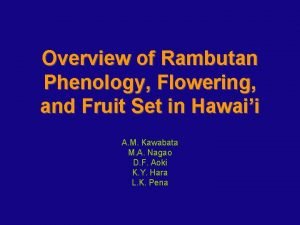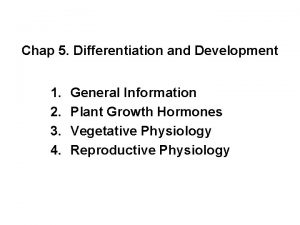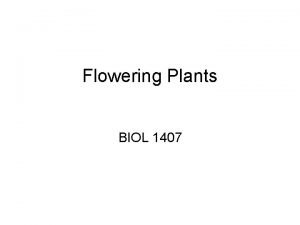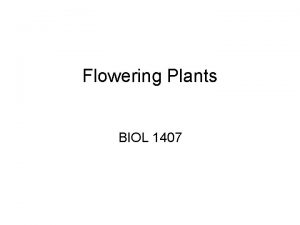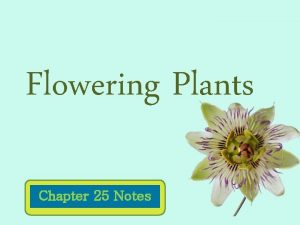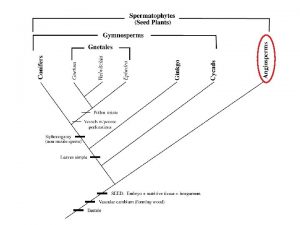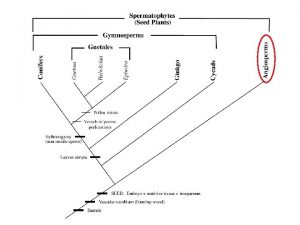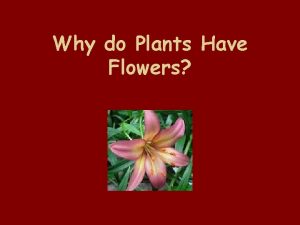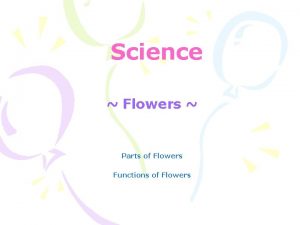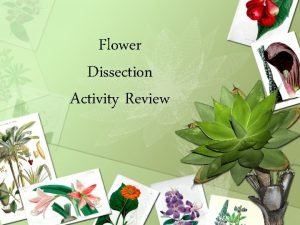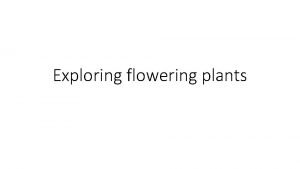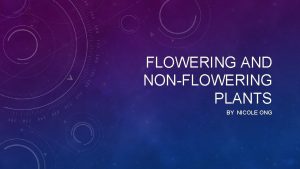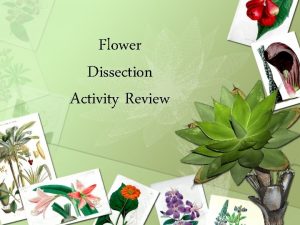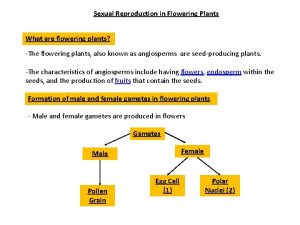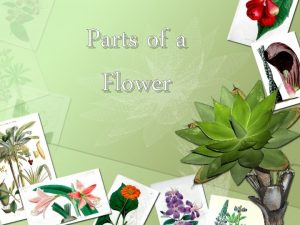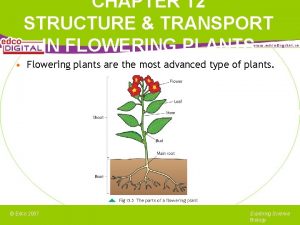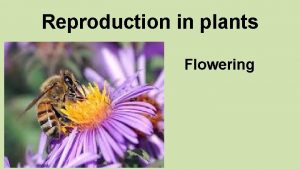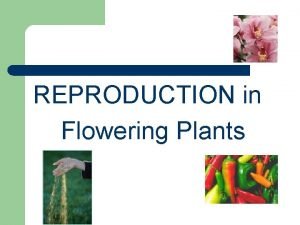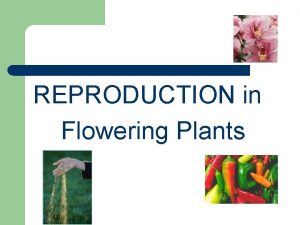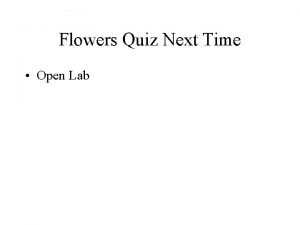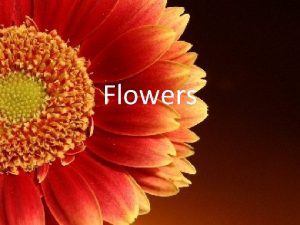Flowers Division Anthophyta contains the flowering plants or






































- Slides: 38

Flowers

Division Anthophyta contains the flowering plants, or Angiosperms. Flowering plants are similar to non-flowering seed plants (Gymnosperms) in having advanced vascular tissue, a dominant sporophyte stage, a markedly reduced gametophyte stage, and production of seeds. Seeds are important adaptations for terrestrial life because they protect the sporophyte embryo from the environment, they provide nutrients to the embryo, and they can remain dormant during stressful conditions. Angiosperms differ from gymnosperms by the production of a derived organ, the fruit. Angiosperm ovules are enclosed in a carpel. After fertilization, the ovule develops into the seed and the carpel develops into the fruit. Angiosperms also produce flowers, which are structures containing the reproductive organs of the sporophyte. The flower functions to protect the gamete and to aid in dispersal of male gametes (pollination) and fertilization of eggs. Anthophyta

Introduction • Receptacle = Place on stem where floral organs originate & attach • Sepals = Lowest order of floral organs, first to develop, can be green & leaflike, Collectively = Calyx • Petals = Inserted on the Receptacle just above the Sepals, usually brightly colored, Collectively = Corolla • Perianth = Collective term for Sepals + Petals • Pistil- collective term for carpel(s). The terms CARPEL and PISTIL are equivalent when there is no • fusion, if fusion occurs then you have 2 or more CARPELS united into one PISTIL. • Stamen = Inserted above petals, consists of anther & filament, Collectively = Androecium • Anther - Part of stamen that produces pollen • Filament - Stalk that bears the anther • Carpel = Inserted above stamens, uppermost floral organ, consists of stigma, style & ovary, Collectively = Gynoecium • Stigma - Tip of the carpel, receptive to pollen • Ovary - Base of the carpel, contains ovules • Style - Connects the stigma to the ovary • Adnation - Fusion of floral parts from different whorls.


Introduction A flower can have four types of specialized leaf whorls, the (1) calyx and (2) corolla (sterile) as well as the (3) androecium (microsporophylls) and (4) gynoecium (megasporophylls). Most flowers have all four, but in some cases, one or more of the whorls has been secondarily lost. A flower that has • sepals • petals • stamens • carpels. . . is said to be a complete flower. A flower that lacks one or more of these whorls is said to be an incomplete flower.

Floral Morphology Flower parts include: • Receptacle • Peduncle • Perianth – sepals (calyx) – petals (corolla) • Androecium – stamens • filaments • anthers – pollen – connective • Gynoecium – carpels • ovary • style • stigma

Completeness • Complete - Has all four floral organs • Incomplete - One or more floral organs missing • Perfect - Flower with Androecium & Gynoecium • Imperfect - Missing Androecium OR Gynoecium – staminate – has stamens only – carpellate – has carpels only

Plant conditions • Synoecious - when all the flowers of an individual contains both male and female parts (the flowers are perfect); • Monoecious (one house) One plant has BOTH carpellate & staminate flowers; • Dioecious (two houses)one plant has only staminate flowers & another plant has only carpellate flowers.

Ovulary Position • superior ovary – hypogynous flower - other floral organs attached below the gynoecium on the receptacle. • half-inferior – perigynous flower - sepals, petals & stamens arise from a tubular extension of the receptacle called the hypanthium which surrounds the ovary but is NOT fused to the ovary wall. • inferior ovary - epigynous - stamens, petals & sepals appear to grow from the top of the ovary

Female gametophyte

Inflorescences Flowers may be borne singly, on a peduncle, or in a cluster called an inflorescence. The tiny stalk of an individual flower in an inflorescence is called a pedicel.

Indeterminate Inflorescences An indeterminate inflorescence has new buds growing at the apex while mature flowers appear on lower pedicels. Buds open first from the base of the inflorescence.

Determinate Inflorescences A determinate inflorescence has new buds growing at the base while mature flowers appear on upper pedicels. Buds open first at the top of the inflorescence.

Flower symmetry In order to describe the shape of flowers, we often speak of the symmetry of the flower. For example, if one looks down at a buttercup flower, with many whorls of petals, stamens and carpels, you can dissect the flower into many planes of symmetry (plane of symmetry = bisecting an object into 2 mirror images). Buttercups have radial symmetry. If on the other hand, one looks at an orchid flower, with its highly derived characteristics, one can only find one plane of symmetry. This is bilateral symmetry. There are cases, such as in the mustard family, where one commonly finds two planes of symmetry, and this is biradial symmetry. And there are cases where flowers are so asymmetrical that there are no planes of symmetry, and this is asymmetrical.

Pollination It is often possible to determine what type of pollination/pollinator a plant uses by the structure, color, shape, and smell of the flower. You should be familiar with this table:

Floral formulas and diagrams A floral formula consists of five symbols indicating from left to right: • Floral Symmetry • Number of Sepals • Number of Petals • Number of Stamens • Number of Carpels

Somewhere you can find these symbols:

Floral formula

Floral Formula Symbol 1 The first symbol in a floral formula describes the symmetry of a flower. • (* or ) Radial symmetry – Divisible into equal halves by two or more planes of symmetry (actinomorphic flower). • (+) Bilateral symmetry – Divisible into equal halves by only one plane of symmetry. • ($) Asymmetrical – Flower lacking a plane of symmetry, neither radial or bilateral. • If there is only one plane of symmetry, then the flower is zygomorphic and is represented by

Floral Formula Symbol 2 The second major symbol in the floral formula is the number of sepals, with “K” or “Ca” representing “calyx”. Thus, K 5 would mean a calyx of five sepals. 20

Floral Formula Symbol 3 The third symbol is the number of petals, with “C” or “Co” representing “corolla”. Thus, C 5 means a corolla of 5 petals. 21

Floral Formula Symbol 4 The fourth symbol in the floral formula is the number of stamens (androecial items), with “A” representing “androecium”. A∞ (the symbol for infinity) indicates numerous stamens and is used when stamens number more than twelve in a flower. A 10 would indicate 10 stamens. 22

Floral Formula Symbol 5 The fifth symbol in a floral formula indicates the number of carpels, with “G” representing “gynoecium”. Thus, G 10 would describe a gynoecium of ten carpels. • A line below the carpel number indicates the superior position of the ovary with respect to other floral parts. • A line above the carpel number indicates the inferior position of the ovary with respect to other floral parts. 23

Basic Floral Formula *K 5, C 5, A∞, G 10 Radial symmetry (*), 5 sepals in the calyx (K 5) 5 petals in the corolla (C 5) Numerous (12 or more) stamens (A∞) 10 carpels (G 10) 24

More examples

More on Floral Formulas Connation (like parts fused) is indicated by a circle around the number representing the parts involved. For example: 26

More on Floral Formulas The plus symbol (+) is used to indicate differentation among the members of any floral part. For example, a flower with five large stamens alternating with five small ones would be recorded as: A 5 + 5. 27

More on Floral Formulas The lack of a particular floral part is indicated by placing a zero (0) in the appropriate position in the floral formula. For example, a carpellate flower (flower with a gynoecium but no functional androecium) would be described as: • *, K 3, C 3, A 0, G 2 28

More on Floral Formulas Flowers with a perianth of tepals (no differentation between calyx and corolla) have the second and third symbols combined into one. A hyphen (-) is placed before and after the number in this symbol. Example: • *, T-5 -, A 10, G 3 Sometimes instead of „T“ you can find „P“ which stands for perianth. 29

Floral Diagrams Floral diagrams are stylized cross sections of flowers that represent the floral whorls as viewed from above. Rather like floral formulas, floral diagrams are used to show symmetry, numbers of parts, the relationships of the parts to one another, and degree of connation and/or adnation. Such diagrams cannot easily show ovary position. 30

Floral Diagram Symbols I 31

Floral Diagram Symbols II 32

Sample floral diagrams 33

More examples

More examples

And now let‘s practice

More practice

Sources Big thanks to: http: //www. bio. miami. edu/dana/226 F 09_2 1. html www. msubillings. edu http: //ashipunov. info/shipunov/school/biol_154 /2011_2012/lab_04. pdf http: //crescentok. com/staff/jaskew/ISR/botzo/d iapractice. htm
 Classify non flowering plants with examples
Classify non flowering plants with examples What is classification of plant
What is classification of plant Classification of plants flowering and non flowering
Classification of plants flowering and non flowering Anthophyta reproduction
Anthophyta reproduction Parts of a leaves
Parts of a leaves Cladogram plants
Cladogram plants Main part of seed
Main part of seed Plantae phylum
Plantae phylum Parts of the roots
Parts of the roots Unit 2 lesson 12 flowering plants
Unit 2 lesson 12 flowering plants Multiple choice questions on flowering plants
Multiple choice questions on flowering plants Moss fern gymnosperm angiosperm
Moss fern gymnosperm angiosperm Lesson 12 flowering plants
Lesson 12 flowering plants Tube nucleus
Tube nucleus Study of plants is called
Study of plants is called Events of fertilization in plants
Events of fertilization in plants Are mosses flowering plants
Are mosses flowering plants Food stored in seeds
Food stored in seeds Gcf of 4 and 8
Gcf of 4 and 8 Female parts of a flower
Female parts of a flower Surf grass phylum
Surf grass phylum Apakah ganggang hijau memiliki jaringan pembuluh angkut
Apakah ganggang hijau memiliki jaringan pembuluh angkut Filo anthophyta
Filo anthophyta Vertical
Vertical Pine cone phylum
Pine cone phylum C3 plant
C3 plant Nonvascular plant
Nonvascular plant Non vascular plant reproduction
Non vascular plant reproduction Long division terms
Long division terms Short division vs long division
Short division vs long division Long division and synthetic division
Long division and synthetic division How to synthetic division
How to synthetic division Flowering plum orchard van gogh
Flowering plum orchard van gogh Nitrogen is absorbed by the plants in the form of
Nitrogen is absorbed by the plants in the form of Foreshadowing in romeo and juliet
Foreshadowing in romeo and juliet Diplod
Diplod Rambutan flowering
Rambutan flowering The flowering of romanticism summary
The flowering of romanticism summary Ethylene pineapple flowering
Ethylene pineapple flowering

